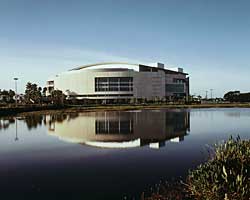
On Defense
Florida sports arena reinvigorates security system
- By Megan Weadock
- Aug 02, 2007
 IN a sea of 20,000 people at a concert or sports event, security becomes even more complicated than usual. Controlling access to certain areas, tracking visitors effectively and protecting physical assets—all while ensuring the safety of those thousands of people and staff members—can be task overwhelming tasks for most security professionals.
IN a sea of 20,000 people at a concert or sports event, security becomes even more complicated than usual. Controlling access to certain areas, tracking visitors effectively and protecting physical assets—all while ensuring the safety of those thousands of people and staff members—can be task overwhelming tasks for most security professionals.
However, when the BankAtlantic Center in Sunrise, Fla., updated its security system and methods, security officials were able to use cutting-edge technology to make the task of security easier.
Since being built in 1998, the BAC has been home to the Florida Panthers hockey team and has become a popular venue for a range of musicians, sporting events, stage productions and other performers.
"It was designed, quite frankly, to be the premier venue of its kind in South Florida and one of the elite venues worldwide," said Michael Yormark, COO of Sunrise Sports and Entertainment at the center. "It is one of the rare facilities that houses a full-time professional sports franchise, but can also accommodate nearly any type of sporting event—from basketball to bull riding to monster truck rallies—or any type of concert without skipping a beat."
BAC has roughly 870,000 square feet of space and can house up to 20,000 people for a single event. More than 2 million guests visit the center each year, and the area around the center is constantly busy, thanks to its proximity to Florida's second-largest tourist attraction, the Sawgrass Mills Mall. The continuous hustle-bustle, combined with the demands of the center's flow of ever-changing events, presented a unique security challenge.
A New Strategy
"A post-9/11 world requires us to recognize many possibilities," said Bram Bottfeld, director of security and safety for Sunrise Sports and Entertainment. "The BAC features an extremely transient population, given the number of events that occur within and around it. While some of our safety concerns may not seem unique, doing it all at the same time is quite unique."
When Bottfeld joined the staff last year, he and Yormark decided to change the old, unorganized security methods to a formalized and centralized system.
"When Bram was hired, we made it clear that we wanted to constantly evaluate our strategies and resources," Yormark said. "One of the first things he did was a complete analysis of our security system. What he found was an apparent lack in a number of areas that could only be fixed with a complete system overhaul."
Yormark supported the renovation because he wanted to hold BAC's security up to higher standards.
"The BankAtlantic Center is a world-class facility, and we felt it was important to maintain high expectations for every area of our business. Security was no exception," he said.
After Bottfeld's analysis revealed the flaws in the center's security system, he and Yormark looked to better secure the facility.
Upping Their Game
Yormark said they took plenty of time to assess the center's needs, as well as review proposals and evaluate available technology.
They knew the change was going to be a big one. The old system used VHS-based recording, black-and-white cameras and a very limited access control system. Bottfeld said it also limited PTZ use of cameras and lacked IR vistas and event logs.
"There was an inability to edit access per individual unit, no sequential event log, no real-time view of images, no good view of recorded images, no pre-recorded tours and no ability to have cameras roam independent of operators," he said.
Yormark and Bottfeld knew the solution would require countless updates to secure the diverse crowds of visitors the center sees each year, the sports figures and personalities performing there, the center's numerous staff members and its physical assets.
With many complex factors to consider for the new system, the pair chose ADT as their systems integrator because of a history with the company and its reputation.
"As a longstanding partner and a worldwide security leader, it was clear ADT could provide us with a comfort level and a level of service that we couldn't find anywhere else," Yormark said.
Phase one of the implementation took place in December 2006. In this stage, black-and-white cameras were changed to a remote-operated color system. The VHS-based recording system also was replaced with a 1.4-Terabyte DVR.
For the first time, quiet surveillance units were placed throughout the center. These cameras help secure the center—regardless of the event or crowd size. For example, one concern was the Panthers' hockey sticks, which had been repeatedly stolen under the old system. But with new cameras trained on the area, the equipment is much safer.
ADT also updated BAC's access control tactics, which are important in any expansive facility. Employees started using access badges—instead of actual keys—which allow security officials to track improper card use. With the new surveillance units, a live camera image can simultaneously confirm the same event. Bottfeld said security officials now can regulate levels of access more fully.
However, BAC's security overhaul wasn't just about new cameras and badges.
"The system is more than the hardware and the technology. It is also the spirit of the program and the staff," Bottfeld said. "New staff is oriented as to the security goals for the facility. We proactively train both building security staff in ways to protect and safeguard themselves. The true adaptability of the system is that those making it work can apply both the technology and their training to the situation."
Reaching the Goal
After finally making a move to an updated security system, both officials are seeing results.
"We're now better able to manage entry, and our ability to view and review the occurrences has been enhanced 10 times from where it was," Bottfeld said.
However, Yormark said the new system is just the beginning of a continual process.
"It is our job, as maintainers of one of the world's elite venues, to constantly evaluate our security on an almost daily basis. The safety of our guests, staff, performers and all of our other constituents has and will always be one of our top priorities," he said.
Phases two and three of the security model are currently being planned and will be put in place in the near future. BAC will receive an additional 40 to 60 cameras, an updated evacuation plan, more card reader stations and a wireless camera unit for direct connectivity to the local police department.
"We constantly review our plans and revamp them as needed. A change, if you will, is that we took pride in the security program again and received consistent management support to make it effective," Bottfeld said. "Without that, security has no hope of being successful."